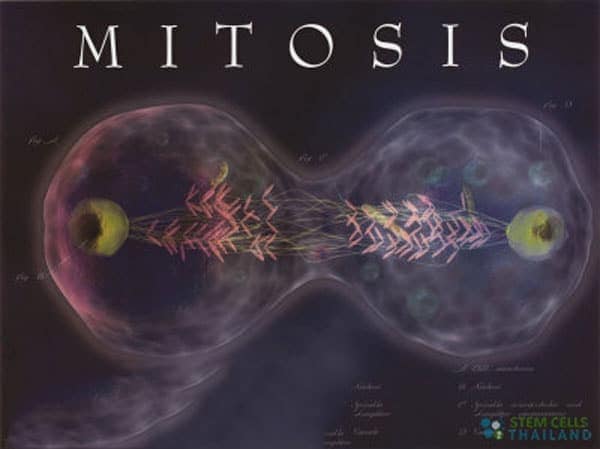
All cells have to eventually duplicate. in nature, there are 2 main methods of cell duplication. Mitosis and Meiosis.
Mitosis is the exact opposite of cell duplication through meiosis where the chromosome population is split in half. [1] This fundamental process of cell division allows for each new cell to retain their original chromosome numbers, allowing other cell types to increase or maintain its populations. Mitosis and the process known as cytokinesis define the “M” mitotic phase of the cell division cycle. In this process, the mother cell will form into two distinct daughter cells.[2]
Mitosis is the process by which a single eukaryotic cell divides to produce two daughter cells, each containing an identical set of chromosomes. This is crucial for growth, development, and tissue repair in multicellular organisms. Mitosis ensures that each daughter cell receives a full set of chromosomes, preserving the genetic information of the parent cell.
While not technically a phase of mitosis, cytokinesis usually occurs shortly after mitosis. It involves the division of the cytoplasm, resulting in the formation of two separate daughter cells. In animal cells, this is achieved through the formation of a cleavage furrow, which pinches the cell into two. In plant cells, a cell plate forms in the middle and eventually develops into a new cell wall, dividing the cell into two.
It’s important to note that mitosis is just one part of the cell cycle. Before entering mitosis, cells go through a phase called interphase, which includes G1 (gap 1), S (synthesis, where DNA is replicated), and G2 (gap 2) phases. Interphase is a period of growth and preparation for the cell to undergo mitosis.
When the cells duplicate through mitosis, two identical cells are formed in the gastrulation process.[3]There are five basic phases in the life-cycle of all cells. The Phases are known as PMATI (pronounced PeeMahtEee). The 5 phases of mitosis are:
The process of Mitosis ends with telophase which is the point that our chromosomes reach the poles. After this stage, the nuclear membrane begins to reforms, and chromosomes start to decondense into the interphase conformation. The telophase stage is followed by cytokinesis, which is the division of the cytoplasm into 2 daughter cells. Daughter cells which are formed in this process have identical compositions genetically.
[1] ^ Boettcher, Barbara, and Yves Barral. 2013. The cell biology of open and closed mitosis. Nucleus (Austin, Tex.), no. 3 (April 15). doi:10.4161/nucl.24676. https://www.ncbi.nlm.nih.gov/pubmed/23644379
[2] ^ Heijink, Anne Margriet, Małgorzata Krajewska, and Marcel A T M van Vugt. 2013. The DNA damage response during mitosis. Mutation research, no. 1-2 (July 21). doi:10.1016/j.mrfmmm.2013.07.003. https://www.ncbi.nlm.nih.gov/pubmed/23880065
[3] ^ Kuffer, Christian, Anastasia Yurievna Kuznetsova, and Zuzana Storchová. 2013. Abnormal mitosis triggers p53-dependent cell cycle arrest in human tetraploid cells. Chromosoma, no. 4 (April 28). doi:10.1007/s00412-013-0414-0. https://www.ncbi.nlm.nih.gov/pubmed/23624524
If you've seen people take ice baths or cold showers and wondered if they're onto… Read More
Immunomodulation stands at the forefront of biomedical research, steering the immune system's ability to fight… Read More
Stem cell research leads the charge in medical innovation, heralding revolutionary advances in regenerative medicine.… Read More
The blood-brain barrier (BBB) is a crucial shield for the brain, regulating the entry of… Read More
While peptide bonds are fundamental to protein structure, their direct relationship with stem cells lies… Read More
When discussing cutting-edge cancer treatments, NK cell therapy stands out due to its unique approach… Read More